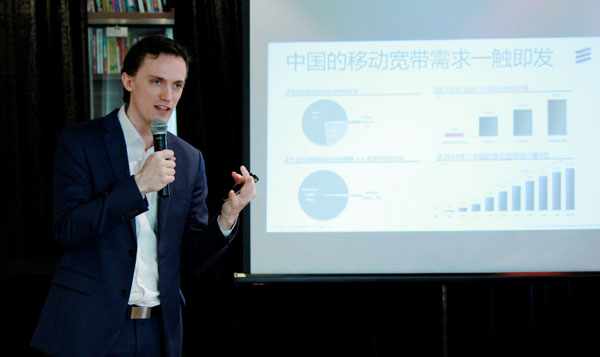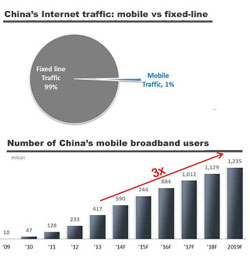Videos eat up 50% mobile data
By Yu hongyan (chinadaily.com.cn) Updated: 2014-05-28 16:30
 |
|
Jean-Christophe Laneri, mobile broadband solution director of Ericsson Northeast Asia, delivers a speech at an Ericsson workshop in Beijing, May 27, 2014. [Photo/Provided to chinadaily.com.cn] |
Mobile users spent 80 percent of total usage time on apps in 2013, and that is projected to grow to 86 percent in 2014, according to Flurry Analytics.
 |
|
Source: Flurry Analytics/Ericsson |
Telecom operators' constant investment on network quality will bring them economic benefits through saving costs and increasing revenues, according to a report by Ericsson.
The report studied telecom operators in the US, Mexican and Brazilian markets, and found that as operators added 10 percent in capital expenditure each year, they all saw increase in service revenue, EBITDA, and free cash flow.
Ericsson raised the concept of "application coverage" last year. As the telecom industry evolves into mobile broadband era, the assessment on mobile coverage should now be based on the experience of using certain mobile applications, Jean-Christophe Laneri, mobile broadband solution director of Ericsson Northeast Asia Region, said at the workshop.
At the downlink speed of 1 megabits per second (Mbps), application coverage of China's three telecom operators is around 80 to 90 percent, as of February 2014. That is close to Ericsson's standard of 95 percent. The challenge now for Chinese operators is to achieve 50-percent application coverage at the downlink speed of 10 Mbps, according to Lenari.
|
 |
|
Source: MIIT, CNZZ.com, GSMA, Mobida |
Another challenge comes from the surging mobile traffic which is predicted to grow tremendously in the future.
Mobile traffic takes only 1 percent of China's total Internet traffic, far below the 15 percent of the world's average proportion. Besides that, mobile traffic of smartphone users in the Chinese mainland accounts for only one tenth of that in the mature markets. However, the number of China's mobile broadband users is expected to grow three times by 2019, according to Lenari.
Chinese telecom operators are aware that they need to look at smartphone user experience, which is on top of their agenda, said Lenari.
As operators are competing on the 4G market, Lenari told them to fulfill minimum user experience in the first place, by providing constant service, instead of simply focusing on flashy downlink speed that would not ensure constancy.
- Online games are transformed by speedier connections
- Ericsson's new Dot base station to support 4G
- Swedish official opposes to EU probe into Huawei, ZTE
- Ericsson eyes China's new 4G network tender
- Ericsson to acquire Microsoft's IPTV unit
- Huawei set to beat Ericsson
- China Mobile to start 4G operations in HK
- Preparing for a 4G network across China
- Beijing subways to get 4G coverage
- China Mobile lowers data price by 40% on 4G service packages
- China Mobile launches 4G iPhone
- China to increase broadband coverage in western region
- China Mobile hits profit slump amid competition, new projects
- China to invest 160b yuan in 4G projects
- Central China Securities plans $300m IPO next month
- China to expand online personal credit database nationwide
- China to boost funding for local govt that cut emissions
- China Broadcasting Network launched
- China Vanke says property sector's 'golden era' over
- Graduates' expected salary falls
- CNPC sees to invest at least $2b in Peru
- China drafting Beijing-Tianjin-Hebei development plan
















